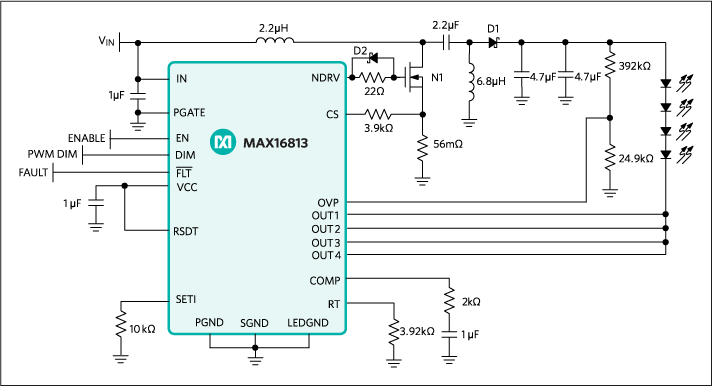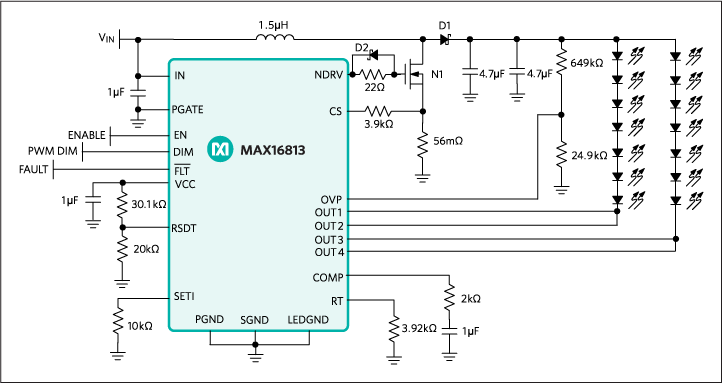The automotive electronics race is heating up. Consumers expect the latest and greatest electronic conveniences, and car manufacturers are increasingly looking to electronics to differentiate their models from the competition. One particular piece of technology, the heads-up display (HUD), is gaining notable traction in the automotive market today. Worldwide sales of vehicles with HUDs are expected to soar from 1.2 million in 2012 to 9.1 million in 2020.2
HUDs work by projecting an image, usually from a liquid crystal display (LCD), onto the windshield or a piece of glass above the instrument cluster. They display useful information such as speed, fuel gauge, lane guidance, navigation, and driver assistance warnings. The image is usually collimated, meaning that the light rays run parallel to the driver’s line of sight. This causes the displayed information to appear to float on the road ahead at optical infinity.
By displaying information with a HUD, the driver’s attention can stay focused on the road. Researchers from Cambridge Consultants agree that HUDs, in line with the driver’s view of the road ahead without distraction, can provide the visual alerts from Advanced Driver Assistance Systems (ADAS) far better than the conventional dashboard displays and color screens.3 Thus, not only are HUDs a cool piece of technology useful in differentiating a car, but they also contribute to a safer driving experience.
Designing a good HUD presents many challenges. It needs to have a very wide contrast ratio. It must display an image bright enough to be clearly seen on a sunny day, but also dim the image so that it does not obscure the driver’s vision at night. For a HUD image to be clearly visible, the HUD contrast ratio (Equation 1) should be between 1.15 and 1.5.
HUD contrast ratio = (Display Luminance + Ambient luminance)/(Ambient luminance) (Eq. 1)
The image may be undetectable for contrast ratios lower than 1.15; contrast ratios greater than 4 can make viewing uncomfortable.4
On a moonless night, ambient luminance can be as low as 10-3 candelas per square meter (cd/m2). Ambient luminance could be as high as 10,000cd/m2 in full daylight.5 The car’s headlights will increase the ambient luminance somewhat at night, but it is still obvious that the luminous intensity of the HUD must vary widely to accommodate the driving environment.
The luminous intensity of the HUD is set by the light-emitting diodes (LEDs) that backlight the LCD. These LEDs are controlled with a high-brightness (HB) LED driver circuit. A typical HB LED driver integrates a switch-mode power supply with constant-current sinks for each LED string. When designing a HUD, the LED driver should be chosen principally for its input voltage range, desired switching frequency, dimming capability, and the size of the display. Modern HB LED drivers capable of very wide dimming ratios are well suited for the challenge.
The MAX16813 HB LED driver integrates a boost/SEPIC current-mode controller with four integrated current sinks that can be configured for up to 150mA each. The current sinks can also be paralleled, as in Figures 1 and 2, to sink up to 600mA through a single LED string or 300mA each through a pair of LED strings. The device offers a wide 4.75V to 40V input voltage range and can withstand standard automotive battery transients such as load dump and cold crank. The device also offers a very wide 10,000:1 PWM dimming ratio. This ensures that the HUD displays a clear image in bright sunlight and a subdued image that will not obscure the driver’s vision at night.

A typical SEPIC application circuit for an HB LED driver, the MAX16813, for use in HUDs. This SEPIC configuration would be used when the LED string voltage is between the minimum and maximum expected input voltage.

A typical boost application circuit for use in HUDs. The MAX16813 HB LED driver is again featured. This boost configuration would be used when the LED string voltage is greater than the maximum expected input voltage.
As the song goes, “Days may be cloudy or sunny…come rain or shine,” but a properly designed HUD will shine in any weather.
Advertisement
Learn more about Maxim Integrated





